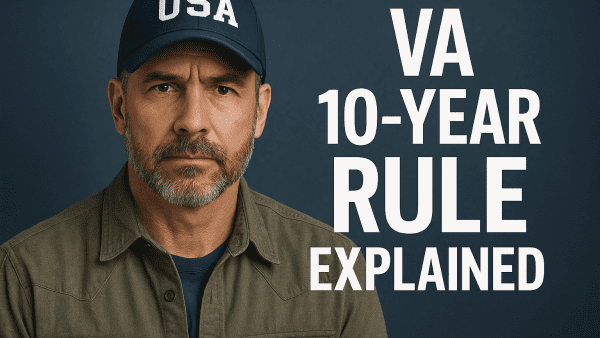Looking for Expert-Level VA Claim Answers?📱Call Us Now! 737-295-2226
If your VA claim was denied or you received a lower disability rating than you deserve, filing a Supplemental Claim gives you the chance to submit new and relevant evidence that wasn’t previously considered, allowing your case to be re-examined.
Supplemental Claims are a crucial part of the VA’s Decision Review and Appeals Process, designed to provide veterans with a simplified and faster way to challenge a prior rating decision.
By offering the opportunity to present fresh evidence, this process provides a more efficient path to reconsideration without the need for a lengthy traditional appeal.
So, what are the steps in the Supplemental Claim process, and how long does each one take?
Let’s walk through each phase of the process, outlining key actions and the typical timeline from submission to decision.
Table of Contents
Summary of Key Points
- What is a Supplemental Claim? A Supplemental Claim allows veterans to submit new and relevant evidence that wasn’t considered in the original decision, offering the opportunity to have the VA re-examine their case.
- Part of the VA Appeals Process: Supplemental Claims are a crucial part of the VA’s streamlined Decision Review and Appeals Process, designed to simplify and speed up the challenge of a prior rating decision.
- Timelines for Each Step: The VA says the average Supplemental Claim takes about 79 days, but real-world experience tells us most veterans should plan on 150 to 180 days from start to finish. The timeline generally includes three phases: claim submission and initial review (1-2 months), evidence gathering and review (2-4 months), and rating and decision (1-2 months).
- Back Pay and Effective Date: If filed within one year of the original decision, the effective date for back pay will be preserved from the original claim. If filed after one year, the effective date will be the date of the new Supplemental Claim.
What is the VA Supplemental Claim Timeline?
The VA Supplemental Claim process typically takes 150-180 calendar days (5-6 months) from start to finish.
The timeline is broken down into three main phases: (#1) Submission and Initial Review (1-2 months), (#2) Evidence Gathering and Review (2-4 months), and (#3) Rating and Decision (1-2 months).
Note: The entire process can vary based on the complexity of the claim, the type of evidence being reviewed, and whether new C&P exams are needed.
The VA Supplemental Claim Process with Timelines by Step
| Step | Description | Timeline | Who is Involved |
|---|---|---|---|
| Step #1: Supplemental Claim Submission and Initial Review | The veteran submits the VA Form 20-0995 (Supplemental Claim) along with new and relevant evidence not previously considered, such as service treatment records, private medical evidence, or lay/witness statements. The VA has a duty to assist in gathering any additional required evidence under 38 CFR § 3.159. | 1-2 months | – The veteran (or representative) – Decision Review Operations Centers (DROCs) – Veteran Service Representative (VSR) |
| Step #2: Evidence Gathering and Review | The VA gathers additional evidence, which may include obtaining medical records, other types of evidence to support the claim, or scheduling a Compensation and Pension (C&P) exam. All evidence is reviewed to ensure it is complete before moving to the rating and decision phase. | 2-4 months | – Veteran Service Representative (VSR) – C&P examiner (if required) |
| Step #3: Rating and Decision | A VA Decision Reviewer examines all the evidence and issues a rating decision. This could result in an approval, an increased disability rating, or a denial based on the new and relevant evidence submitted and reviewed. | 1-2 months | – Veteran Service Representative (VSR) – VA Decision Reviewer |
Step #1: Supplemental Claim Submission and Initial Review (Timeline 1-2 months)
The first step is submitting VA Form 20-0995, known as a Supplemental Claim, which can also be done online.
Use this Supplemental Claim form (VA 20-0995) if you disagree with a prior VA rating decision on your claim and you meet at least 1 of these requirements:
- You have new and relevant evidence to submit, or
- You would like VA to review your claim based on a new law (e.g., the PACT Act)
This form is required to start the process and must be accompanied by new and relevant evidence, such as new medical records, service treatment records, or lay statements from witnesses.
The VA defines “new” as evidence not previously considered, and “relevant” as evidence that proves or disproves something critical to your claim.
Once submitted, the VA has a duty to assist in gathering additional evidence (under 38 CFR § 3.159), which means they may help secure any required documents or information that is new and relevant.
Who is involved during this step?
- The veteran (or their representative) who submits the Supplemental Claim.
- The VA’s initial review team, often working at the Decision Review Operations Centers (DROCs), handles the intake and begins developing the claim.
- The Veteran Service Representative (VSR) assigned to your case who will perform an initial review of the evidence.
Step #2: Evidence Gathering and Review (Timeline 2-4 months)
Once the VA receives the claim and new evidence, they begin the evidence gathering and review phase.
This is the longest step in the VA supplemental claim process.
This may involve obtaining medical records, arranging for a Compensation and Pension (C&P) exam, or gathering other documents as identified by the veteran.
During this phase, the VA reviews all submitted documents along with any additional information they have gathered.
The goal is to ensure that all necessary evidence is in place before a decision is made.
Who is involved?
- The Veteran Service Representative (VSR) who is responsible for reviewing the claim and evidence.
- C&P examiner: Veterans may also be scheduled for a new C&P exam if required to further assess the current disability, “nexus” for service connection, and the severity of symptoms.
Step #3: Rating and Decision (Timeline 1-2 months)
Once the VA has gathered all the relevant evidence, the claim moves to the rating and decision phase, where a VA rater reviews the evidence and issues a new decision.
This decision could result in the approval of the claim, an increase in the veteran’s disability rating, or another denial if the new evidence is not sufficient.
In most cases, this entire process from start to decision can take approximately 5-6 months. However, timelines can vary depending on the complexity of the claim and the type of evidence being gathered.
Who is involved during this step?
- The Veteran Service Representative (VSR) assigned to your case.
- A VA Decision Reviewer (VA rater) analyzes all the new and relevant evidence, including any new C&P exam results. and makes a final decision on the claim.
What About Back Pay and the Effective Date?
Your effective date for back pay depends on whether you filed your Supplemental Claim within one year or after one year of the original decision.
Filing a Supplemental Claim Within One Year of the Original Decision:
If your Supplemental Claim is approved and it is filed within one year of the original decision, your compensation will typically be backdated to the effective date of the original claim.
This means that if the Supplemental Claim is successful, you may be eligible for retroactive benefits (back pay) covering the time from the effective date of your original claim to the date of the new decision.
Filing a Supplemental Claim More Than One Year After the Original Decision:
If you file the Supplemental Claim more than one year after the original decision, the effective date will generally be the date of the new Supplemental Claim, meaning that retroactive benefits will only cover the period starting from the new claim filing date.
Conclusion & Wrap-Up
The VA Supplemental Claim process is a powerful tool for veterans to challenge previous decisions, but it requires submitting new and relevant evidence.
From submission to decision, the Supplemental Claim process typically takes 5-6 months, though the timeline can vary based on individual circumstances.
If you’re unsure about the best way to proceed, reaching out to a VA-accredited representative can be a crucial step in ensuring your Supplemental Claim is as strong as possible.
VA Supplemental Claim Timeline: List of Frequently Asked Questions (FAQs)
What is a Supplemental Claim?
A Supplemental Claim is one of VA’s three decision-review lanes. You use it to submit new and relevant evidence the VA didn’t consider before so a reviewer can take another look at the same issues. When you actually have fresh evidence, this is often the fastest way to fix a denial or an underrated condition without a full Board appeal.
What counts as “new and relevant” evidence?
“New” means VA hasn’t seen it; “relevant” means it helps prove or disprove something that matters in your claim. High-impact examples: updated specialty records, a private nexus/severity opinion, DBQs, new diagnostics (sleep study, audiogram, MRI), service records not previously reviewed, and credible lay/buddy statements. Unless your claim is based on a change in law (like PACT Act presumptives), you must submit new and relevant evidence.
Should I file a Supplemental Claim if my condition got worse?
No. If you’re already service-connected and your symptoms worsened, file a claim for a VA rating increase, not a Supplemental Claim. The increase route evaluates current severity; Supplemental re-opens the prior decision with new evidence.
What is the current VA Supplemental Claim timeline?
Most vets see about 5–6 months end-to-end, though complexity drives speed. A realistic breakdown:
- Step #1, Submission & Initial Review: ~1–2 months
- Step #2, Evidence Gathering & Review: ~2–4 months
- Step #3, Rating & Decision: ~1–2 months
What happens after I file?
The VA develops your claim: requests records, orders exams if needed, and reviews the file. You don’t need to act unless the VA contacts you. If a C&P exam is scheduled, do not miss it.
Who is involved in the process?
You (and any accredited rep), a Veteran Service Representative (VSR) who develops the claim, contract C&P examiners if an opinion/exam is needed, and a VA Decision Reviewer (rater) who issues the decision. Intake typically runs through a Decision Review Operations Center (DROC).
How do I file a Supplemental Claim?
You can file online (disability compensation only), by mail with VA Form 20-0995, in person at a regional office, or with help from an accredited VSO/agent/attorney. If you want VA to obtain private medical records, include VA Form 21-4142—but whenever possible, submit the records yourself to save time.
What about back pay and the effective date?
- Filed within 1 year of the decision: you generally preserve the original effective date, protecting your retroactive back pay.
- Filed after 1 year: effective date is usually the date VA receives the Supplemental Claim, limiting retro to that new date.
What if I disagree with the Supplemental Claim decision?
You have three options:
- Request a Higher-Level Review (HLR) of the denied Supplemental Claim for a de novo look without new evidence,
- Appeal to the Board for a Veterans Law Judge review, or
- File another Supplemental Claim if you’ve got more new and relevant evidence.
How can I strengthen my Supplemental Claim?
Front-load your best evidence and organize it issue-by-issue. Add a brief cover note for each upload (“What this proves”). Submit targeted medical opinions/DBQs, credible lay statements, and up-to-date diagnostics. Respond quickly to VA letters and attend all exams. The cleaner your file, the faster and more accurate the rating.
When should I choose Supplemental vs. Higher-Level Review vs. Board?
- Supplemental Claim: you have new and relevant evidence (or can identify where VA can get it).
- Higher-Level Review: you believe VA misapplied the law or overlooked evidence already in the file—no new evidence allowed.
- Board Appeal: complex legal/medical issues, conflicting opinions, or you want a judge to weigh the evidence.
Do Supplemental Claims have a deadline?
You can file anytime, but to protect your effective date, submit the Supplemental Claim within one year of the decision you’re challenging.
Can I include multiple issues on one Supplemental Claim?
Yes. List each issue separately and attach (or identify) the specific new and relevant evidence for each one. Clear labeling helps the reviewer connect the dots and speeds up the decision.
Will filing a Supplemental Claim reduce my current rating?
Filing alone doesn’t reduce anything. However, if VA orders a new exam and the evidence shows material improvement, VA can propose a reduction with due-process safeguards. Be accurate, consistent, and bring strong medical evidence of current severity.
What if VA missed key service records before?
If truly new, relevant service records are later found, VA must reconsider the claim. In some scenarios that can support earlier effective dates. Flag this explicitly and submit the records.
Does an Intent to File protect my date for a Supplemental Claim?
No. The Intent to File tool protects new or increase claims, not decision-review filings. To preserve your date on a decision review, file the Supplemental Claim within one year of the decision.
Will VA help gather evidence?
Yes—VA has a duty to make reasonable efforts to obtain federal and private records and to provide exams/opinions when needed. You’ll still move faster if you upload the critical records yourself.
Can I request a hearing in the Supplemental lane?
Yes. You may request a hearing at any time while your Supplemental Claim is pending. Hearings can clarify disputed facts, highlight new evidence, and resolve questions that might otherwise delay a grant. Pro Tip: You can request a hearing at any time in the Supplemental Claims process. To request a hearing, call the VA at 1-800-827-1000 (TTY: 711) or request online via Ask VA.
YOU SERVED. YOU DESERVE. We Got Your Six!

- VA Claims Insider is the #1 most trusted name in VA disability claims.
- Work directly with a VA claims coach who can help lead you to VA claim victory.
- 25,000+ disabled veterans served in our membership programs since 2016.
- 30% average rating increase for veterans who complete our #1 rated Elite program.
- 4.7/5.0 average rating out of 6,000+ total reviews; over 5,000 5-star reviews.
About the Author

Brian Reese
Brian Reese is a world-renowned VA disability benefits expert and the #1 bestselling author of VA Claim Secrets and You Deserve It. Motivated by his own frustration with the VA claim process, Brian founded VA Claims Insider to help disabled veterans secure their VA disability compensation faster, regardless of their past struggles with the VA. Since 2013, he has positively impacted the lives of over 10 million military, veterans, and their families.
A former active-duty Air Force officer, Brian has extensive experience leading diverse teams in challenging international environments, including a combat tour in Afghanistan in 2011 supporting Operation ENDURING FREEDOM.
Brian is a Distinguished Graduate of Management from the United States Air Force Academy and earned his MBA from Oklahoma State University’s Spears School of Business, where he was a National Honor Scholar, ranking in the top 1% of his class.



